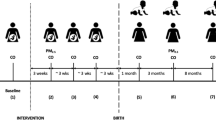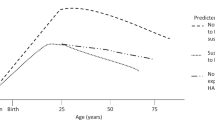Abstract
Background:
In Xuanwei County, Yunnan Province, China, lung cancer mortality rates in both males and females are among the highest in China.
Methods:
We evaluated differential effects of smoking on lung cancer mortality before and after household stove improvement with chimney to reduce exposure to smoky coal emissions in the unique cohort in Xuanwei, China. Effects of independent variables on lung cancer mortality were measured as hazard ratios and 95% confidence intervals using a multivariable Cox regression model that included separate time-dependent variables for smoking duration (years) before and after stove improvement.
Results and conclusion:
We found that the effect of smoking on lung cancer risk becomes considerably stronger after chimney installation and consequent reduction of indoor coal smoke exposure.
Similar content being viewed by others
Main
In Xuanwei County, Yunnan Province, China, lung cancer mortality rates in both males and females are among the highest in China (Mumford et al, 1987), and attributed to polycyclic aromatic hydrocarbon (PAH) and nitrogen heterocyclic compounds contained in smoke from coal combustion (Mumford et al, 1987, 1990).
In a retrospective cohort study conducted in 1992, we noted a significantly decreased risk of incident lung cancer after household stove improvement (Lan et al, 2002). Interestingly, we observed only a weak effect of smoking on lung cancer, which was consistent with previous case–control studies conducted in Xuanwei (He et al, 1991; Lan et al, 2000). Given that cigarette smoking has been strongly related to high incidence or mortality of lung cancer (Doll and Peto, 1981), we suspected that high exposure to indoor airborne carcinogens from coal smoke might partly explain the weak effect of smoking in this cohort.
In this study with extended follow-up, we compared the separate effects of smoking on lung cancer mortality before and after stove improvement with chimney.
Materials and methods
Details of this cohort study have been described previously (Lan et al, 2002). In 1992, local administrative records were searched to identify all farmers born between 1917 and 1951 who were living in Xuanwei's communes as of 1 January 1976. Follow-ups of the study participants (n=42 422) for vital status and cause of death were carried out in 1992 and 1996. As this paper focuses on the effect of smoking before and after stove improvements, women subjects (n=20 721), among which only <1% were ever-smokers, were excluded. Out of 21 701 male subjects, a total of 12 529 (52.2%) installed chimneys, and a total of 6580 changed to portable stoves. For a direct comparison of the results of the Lan et al (2002), change to portable stoves was not considered in this study.
Statistical analysis
To evaluate effects of smoking, the Cox models previously developed for males were slightly modified to estimate hazard ratios (HRs) and 95% confidence intervals (CIs) using the SAS PHREG procedure (SAS 9.1. 3, Cary, NC, USA). The time variable (time axis) was age, starting with age as of 1 January 1976 and ending with age at exit from the follow-up. The outcome event was death from lung cancer. Time-dependent explanatory variables included stove improvement (switching from 0 to 1 at the age of improvement), smoky coal use (tonnage per year), smoking duration (years), and cooking (ever vs never). Non-time-dependent variables included in the models were the same as Lan et al (2002). To adjust for potential birth cohort effects, models were stratified into seven birth cohorts: 1917–1921, 1922–1926, 1927–1931, 1932–1936, 1937–1941, 1942–1946, and 1947–1951.
We further modified the Cox model to estimate the effects of smoking before and after stove improvement, with two separate time-dependent variables of smoking replacing the variable for overall effect of smoking. Then, to estimate the magnitude and statistical significance of interaction between smoking and stove improvement, interaction terms of time-dependent smoking variables with the time-dependent stove improvement variable were added to the Cox models.
As smoking type may have changed over the study period (e.g., from pipe to cigarettes) and the effect on lung cancer risk differs by smoking type (Benhamou et al, 1986), we conducted smoking type-specific analyses. Risks for cumulative exposure (pack-years) to specific smoking types (cigarette: filtered/unfiltered, Chinese long-stem pipe, and water pipe) were characterised and compared in separate reduced data sets for each type, which included exclusive lifetime smokers of each type and non-smokers.
Results
A total of 12 529 subjects (55.2%) changed permanently to stoves with chimney and 9172 (44.8%) did not (the reference group) (Table 1). As previously reported, changing to stoves with chimneys was significantly associated with a reduced risk of lung cancer mortality (HR=0.70, 95% CI=0.62–0.80) (data not shown).
After stove improvement, the effect of smoking duration (per year) on lung cancer mortality significantly increased (HRinteraction=1.015, Pinteraction=0.002) (Table 2). When smoking duration was categorised (i.e., <20, ⩾20–<30, ⩾30–<40, and ⩾40 years), a positive and statistically significant trend was observed after stove improvement, whereas no trend was observed before stove improvement (HRinteraction=1.00, 1.26, 1.51, and 1.62, Ptrend=0.005).
Smoking type-specific analyses showed a significant increase in pre- to post-improvement effects only for cigarette smoking, specifically unfiltered cigarettes (Table 2).
Discussion
Cigarette smoke contains a variety of carcinogens such as PAHs, N-nitrosamines, and aromatic heterocyclic amines, which undergo metabolic activation by cytochrome P450s (CYPs). Major components of particulates from smoky coal combustion in Xuanwei include high levels of PAHs and methylated PAHs (Mumford et al, 1987, 1990). The important difference between the two exposures (i.e., smoke from cigarettes and coal) seems related to the intensity and total dose of carcinogens such as PAHs (Casale et al, 2001). Given that unvented Xuanwei coal smoke contains large amounts of PAHs, perhaps enough to saturate relevant enzyme systems (Lewtas et al, 1997) and to increase DNA repair capacity (Wei et al, 2000), smoking could conceivably have only a weak additional effect on lung cancer risk before stove improvement.
Another possible hypothesis for the weak effect of smoking before stove improvement may be related to activity of enzymes which activate tobacco-specific carcinogens. For example, the activity of CYP2B1, one of the major isozymes, which activate tobacco-specific NNK (4-methylnitrosamino-1-(3-pyridyl)-1-butanone), is lowered after exposure to diesel exhaust particles (DEPs) (Rengasamy et al, 2003) or asphalt fumes (Ma et al, 2003). As PAHs are a major component of smoky coal emissions, as with DEP and asphalt fumes, it is possible that very high exposure to smoky coal emissions may actually lead to lower CYP2B1 activity and therefore weakened effects of smoking on lung cancer mortality. Given insufficient experimental evidence, this hypothesis needs to be investigated by further studies.
Limitations of this study include a lack of information on change of behaviour related to ventilation after the installation of chimneys, as well as no information on clinical characteristics of the cancers occurring before and after stove improvement. Thus, we note that potential confounding cannot be excluded and our results should be interpreted cautiously. Although several previous studies have examined health outcomes related to installation of chimneys (Díaz et al, 2007; McCracken et al, 2007), our study is the first to evaluate differential effects of smoking before and after stove improvement. Our results support additional intervention to promote smoking prevention and cessation after successful reduction of indoor air pollution in this population.
In conclusion, our results suggest that the effect of smoking on lung cancer risk becomes considerably stronger after chimney installation and consequent reduction of indoor coal smoke exposure. Unvented coal smoke exposure could attenuate the effect of smoking on lung cancer mortality, especially in China where relative risks of smoking for overall mortality and lung cancer mortality are considerably lower than those to that in the west (Gu et al, 2009).
Change history
29 March 2012
This paper was modified 12 months after initial publication to switch to Creative Commons licence terms, as noted at publication
References
Benhamou S, Benhamou E, Flamant R (1986) Lung cancer risk associated with cigar and pipe smoking. Int J Cancer 37 (6): 825–829
Casale GP, Singhal M, Bhattacharya S, RamaNathan R, Roberts KP, Barbacci DC, Zhao J, Jankowiak R, Gross ML, Cavalieri EL, Small GJ, Rennard SI, Mumford JL, Shen M (2001) Detection and quantification of depurinated benzo[a]pyrene-adducted DNA bases in the urine of cigarette smokers and women exposed to household coal smoke. Chem Res Toxicol 14: 192–201
Doll R, Peto R (1981) The causes of cancer: quantitative estimates of avoidable risks of cancer in the United States today. J Natl Cancer Inst 66: 1191–1308
Díaz E, Smith-Sivertsen T, Pope D, Lie RT, Díaz A, McCracken J, Arana B, Smith KR, Bruce N (2007) Eye discomfort, headache and back pain among Mayan Guatemalan women taking part in a randomized stove intervention trial. J Epidemiol Community Health 61 (1): 74–79
Gu D, Kelly TN, Wu X, Chen J, Samet JM, Huang JF, Zhu M, Chen JC, Chen CS, Duan X, Klag MJ, He J (2009) Mortality attributable to smoking in China. N Engl J Med 360 (2): 150–159
He XZ, Chen W, Liu ZY, Chapman RS (1991) An epidemiological study of lung cancer in Xuan Wei County, China: current progress. Case-control study on lung cancer and cooking fuel. Environ Health Perspect 94: 9–13
Lan Q, Chapman RS, Schreinemachers DM, Tian L, He X (2002) Household stove improvement and risk of lung cancer in Xuanwei, China. J Natl Cancer Inst 94 (11): 826–835
Lan Q, He X, Costa DJ, Tian L, Rothman N, Hu G, Mumford JL (2000) Indoor coal combustion emissions, GSTM1 and GSTT1 genotypes, and lung cancer risk: a case-control study in Xuan Wei, China. Cancer Epidemiol Biomarkers Prev 9 (6): 605–608
Lewtas J, Walsh D, Williams R, Dobiás L (1997) Air pollution exposure-DNA adduct dosimetry in humans and rodents: evidence for non-linearity at high doses. Mutat Res 378 (1-2): 51–63
Ma JY, Rengasamy A, Frazer D, Barger MW, Hubbs AF, Battelli L, Tomblyn S, Stone S, Castranova V (2003) Inhalation exposure of rats to asphalt fumes generated at paving temperatures alters pulmonary xenobiotic metabolism pathways without lung injury. Environ Health Perspect 111 (9): 1215–1221
McCracken JP, Smith KR, Díaz A, Mittleman MA, Schwartz J (2007) Chimney stove intervention to reduce long-term wood smoke exposure lowers blood pressure among Guatemalan women. Environ Health Perspect 115 (7): 996–1001
Mumford JL, He XZ, Chapman RS, Cao SR, Harris DB, Li XM, Xian YL, Jiang WZ, Xu CW, Chuang JC, Wilson WE, Cooke M (1987) Lung cancer and indoor air pollution in Xuan Wei, China. Science 235 (4785): 217–220
Mumford JL, Helmes CT, Lee XM, Seidenberg J, Nesnow S (1990) Mouse skin tumorigenicity studies of indoor coal and wood combustion emissions from homes of residents in Xuan Wei, China with high lung cancer mortality. Carcinogenesis 11 (3): 397–403
Rengasamy A, Barger MW, Kane E, Ma JK, Castranova V, Ma JY (2003) Diesel exhaust particle-induced alterations of pulmonary phase I and phase II enzymes of rats. J Toxicol Environ Health A 66 (2): 153–167
Wei Q, Cheng L, Amos CI, Wang LE, Guo Z, Hong WK, Spitz MR (2000) Repair of tobacco carcinogen-induced DNA adducts and lung cancer risk: a molecular epidemiologic study. J Natl Cancer Inst 92 (21): 1764–1772
Acknowledgements
This study were supported by the Chinese Academy of Preventive Medicine, Beijing, China; Yunnan Province Antiepidemic Station, Kunming, China; US Environmental Protection Agency (contract No 5D2290NFFX); and Intramural Research Programme of the NIH, Division of Cancer Epidemiology and Genetics, National Cancer Institute.
Author information
Authors and Affiliations
Corresponding author
Rights and permissions
From twelve months after its original publication, this work is licensed under the Creative Commons Attribution-NonCommercial-Share Alike 3.0 Unported License. To view a copy of this license, visit http://creativecommons.org/licenses/by-nc-sa/3.0/
About this article
Cite this article
Lee, KM., Chapman, R., Shen, M. et al. Differential effects of smoking on lung cancer mortality before and after household stove improvement in Xuanwei, China. Br J Cancer 103, 727–729 (2010). https://doi.org/10.1038/sj.bjc.6605791
Received:
Revised:
Accepted:
Published:
Issue Date:
DOI: https://doi.org/10.1038/sj.bjc.6605791



